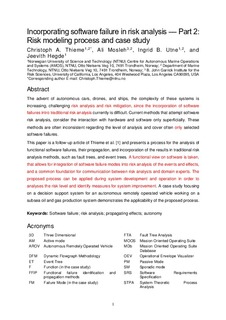| dc.contributor.author | Thieme, Christoph Alexander | |
| dc.contributor.author | Mosleh, Ali | |
| dc.contributor.author | Utne, Ingrid Bouwer | |
| dc.contributor.author | Hegde, Jeevith | |
| dc.date.accessioned | 2020-02-13T08:47:29Z | |
| dc.date.available | 2020-02-13T08:47:29Z | |
| dc.date.created | 2020-02-12T12:31:46Z | |
| dc.date.issued | 2020 | |
| dc.identifier.citation | Reliability Engineering & System Safety. 2020, 198 . | nb_NO |
| dc.identifier.issn | 0951-8320 | |
| dc.identifier.uri | http://hdl.handle.net/11250/2641461 | |
| dc.description.abstract | The advent of autonomous cars, drones, and ships, the complexity of these systems is increasing, challenging risk analysis and risk mitigation, since the incorporation of software failures intro traditional risk analysis currently is difficult. Current methods that attempt software risk analysis, consider the interaction with hardware and software only superficially. These methods are often inconsistent regarding the level of analysis and cover often only selected software failures. This paper is a follow-up article of Thieme et al. [1] and presents a process for the analysis of functional software failures, their propagation, and incorporation of the results in traditional risk analysis methods, such as fault trees, and event trees. A functional view on software is taken, that allows for integration of software failure modes into risk analysis of the events and effects, and a common foundation for communication between risk analysts and domain experts. The proposed process can be applied during system development and operation in order to analyses the risk level and identify measures for system improvement. A case study focusing on a decision support system for an autonomous remotely operated vehicle working on a subsea oil and gas production system demonstrates the applicability of the proposed process. | nb_NO |
| dc.language.iso | eng | nb_NO |
| dc.publisher | Elsevier | nb_NO |
| dc.relation.uri | https://www.sciencedirect.com/science/article/pii/S0951832018307178?dgcid=author | |
| dc.rights | Navngivelse 4.0 Internasjonal | * |
| dc.rights.uri | http://creativecommons.org/licenses/by/4.0/deed.no | * |
| dc.title | Incorporating software failure in risk analysis––Part 2: Risk modeling process and case study | nb_NO |
| dc.type | Journal article | nb_NO |
| dc.type | Peer reviewed | nb_NO |
| dc.description.version | acceptedVersion | nb_NO |
| dc.source.pagenumber | 18 | nb_NO |
| dc.source.volume | 198 | nb_NO |
| dc.source.journal | Reliability Engineering & System Safety | nb_NO |
| dc.identifier.doi | https://doi.org/10.1016/j.ress.2020.106804 | |
| dc.identifier.cristin | 1793456 | |
| dc.description.localcode | © 2020. This is the authors’ accepted and refereed manuscript to the article. Locked until 4.02.2022 due to copyright restrictions. This manuscript version is made available under the CC-BY-NC-ND 4.0 license http://creativecommons.org/licenses/by-nc-nd/4.0/ | nb_NO |
| cristin.unitcode | 194,64,20,0 | |
| cristin.unitname | Institutt for marin teknikk | |
| cristin.ispublished | true | |
| cristin.fulltext | original | |
| cristin.fulltext | postprint | |
| cristin.qualitycode | 2 | |

